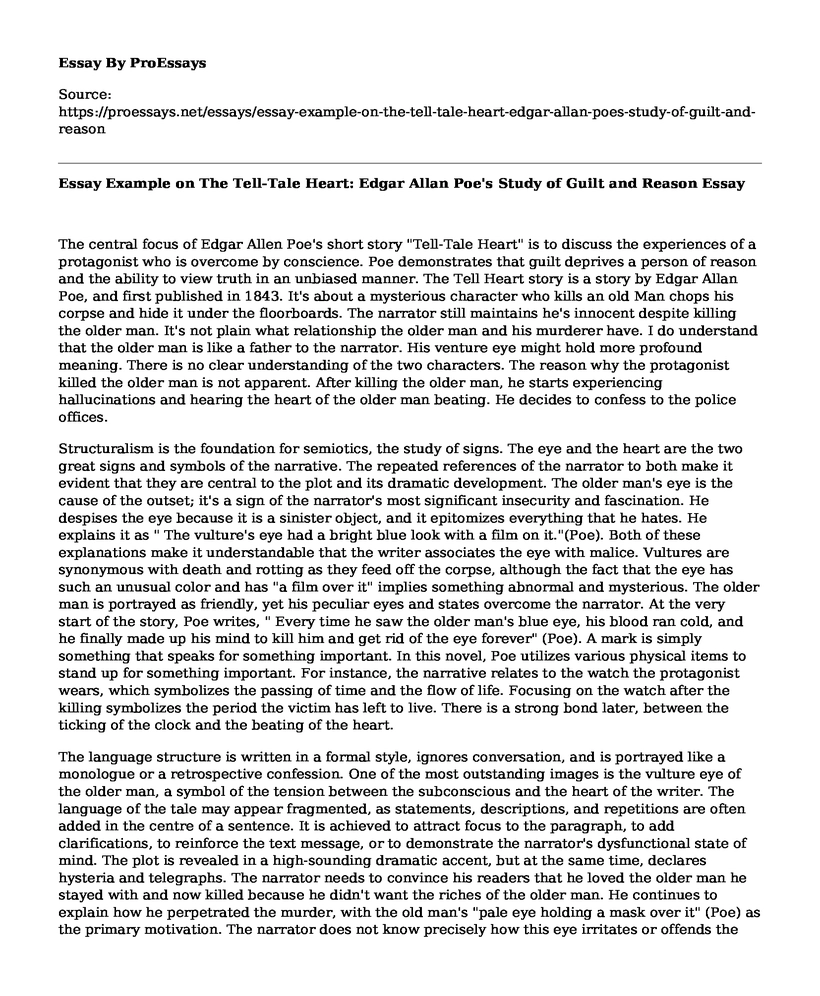The central focus of Edgar Allen Poe's short story "Tell-Tale Heart" is to discuss the experiences of a protagonist who is overcome by conscience. Poe demonstrates that guilt deprives a person of reason and the ability to view truth in an unbiased manner. The Tell Heart story is a story by Edgar Allan Poe, and first published in 1843. It's about a mysterious character who kills an old Man chops his corpse and hide it under the floorboards. The narrator still maintains he's innocent despite killing the older man. It's not plain what relationship the older man and his murderer have. I do understand that the older man is like a father to the narrator. His venture eye might hold more profound meaning. There is no clear understanding of the two characters. The reason why the protagonist killed the older man is not apparent. After killing the older man, he starts experiencing hallucinations and hearing the heart of the older man beating. He decides to confess to the police offices.
Structuralism is the foundation for semiotics, the study of signs. The eye and the heart are the two great signs and symbols of the narrative. The repeated references of the narrator to both make it evident that they are central to the plot and its dramatic development. The older man's eye is the cause of the outset; it's a sign of the narrator's most significant insecurity and fascination. He despises the eye because it is a sinister object, and it epitomizes everything that he hates. He explains it as " The vulture's eye had a bright blue look with a film on it."(Poe). Both of these explanations make it understandable that the writer associates the eye with malice. Vultures are synonymous with death and rotting as they feed off the corpse, although the fact that the eye has such an unusual color and has "a film over it" implies something abnormal and mysterious. The older man is portrayed as friendly, yet his peculiar eyes and states overcome the narrator. At the very start of the story, Poe writes, " Every time he saw the older man's blue eye, his blood ran cold, and he finally made up his mind to kill him and get rid of the eye forever" (Poe). A mark is simply something that speaks for something important. In this novel, Poe utilizes various physical items to stand up for something important. For instance, the narrative relates to the watch the protagonist wears, which symbolizes the passing of time and the flow of life. Focusing on the watch after the killing symbolizes the period the victim has left to live. There is a strong bond later, between the ticking of the clock and the beating of the heart.
The language structure is written in a formal style, ignores conversation, and is portrayed like a monologue or a retrospective confession. One of the most outstanding images is the vulture eye of the older man, a symbol of the tension between the subconscious and the heart of the writer. The language of the tale may appear fragmented, as statements, descriptions, and repetitions are often added in the centre of a sentence. It is achieved to attract focus to the paragraph, to add clarifications, to reinforce the text message, or to demonstrate the narrator's dysfunctional state of mind. The plot is revealed in a high-sounding dramatic accent, but at the same time, declares hysteria and telegraphs. The narrator needs to convince his readers that he loved the older man he stayed with and now killed because he didn't want the riches of the older man. He continues to explain how he perpetrated the murder, with the old man's "pale eye holding a mask over it" (Poe) as the primary motivation. The narrator does not know precisely how this eye irritates or offends the protagonist. The protagonist has a psycho character with no consciousness Poe uses Structuralism to relate a potentially unfamiliar object or concept in a tale to something the reader is conversant with; Such analogies will add a lot of expressions to the tone of a narrative. In this tale, the speaker explains the light from the lantern as "a clear dim ray of length, like a spider's string, shoot from the crevice and fall onto the eye of the vulture" (Poe). Finally, Poe emphasizes the image of the heart symbolizing the guilt of the narrator or his conscience. The main character is trying to destroy it, but he can't achieve that goal. This is one of the aspects derived from the tale.
Work Cited
Poe, Edgar Allan. "The Tell-Tale Heart - Poe's Works | Edgar Allan Poe Museum". Poemuseum.Org,1843, https://www.poemuseum.org/the-tell-tale-heart.
Cite this page
Essay Example on The Tell-Tale Heart: Edgar Allan Poe's Study of Guilt and Reason. (2023, Apr 23). Retrieved from https://proessays.net/essays/essay-example-on-the-tell-tale-heart-edgar-allan-poes-study-of-guilt-and-reason
If you are the original author of this essay and no longer wish to have it published on the ProEssays website, please click below to request its removal:
- Human Duality and Vision of Beauty in Hawthorne's "The Birthmark" - Literary Analysis Essay
- Change, Alienation, and Isolation in "The Metamorphosis" by Franz Kafka Essay
- Identity Crisis as Kurtz's Problem in Heart of Darkness by Joseph Conrad Essay
- An Analysis Essay on Robert Browning's "My Last Duchess"
- Essay Example on Lottery vs Rocking-Horse: Comparing Two Classics
- Essay on Aylmer's Obsession: Nathaniel Hawthorne's 'The Birthmark'.
- Essay Example on The Human Stain: Identity, Change, and Freedom







